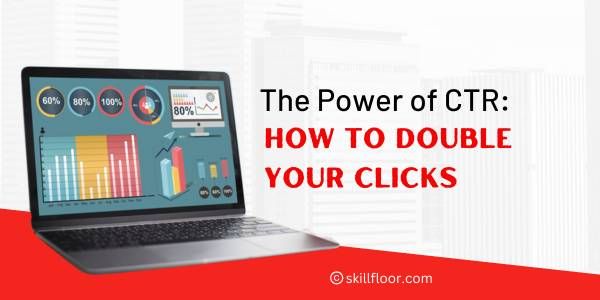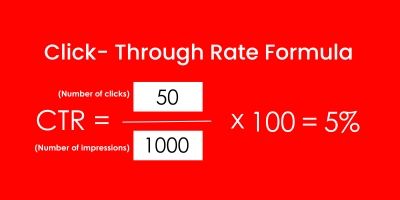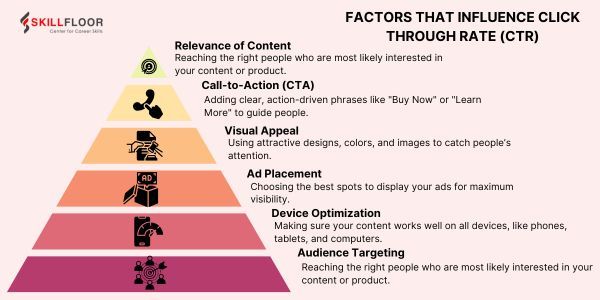What is Click-Through Rate (CTR)?
Learn what Click-Through Rate (CTR) is, how it impacts your digital marketing, and tips to improve it for better online engagement and conversions.

Let me start with a quick question: Did you know that Google Ads' average click-through rate (CTR) is about 3.17% across all industries? I learned this fact when I was running one of my first digital marketing campaigns. After creating what I thought to be the perfect ads, I found that my CTR was far lower than the industry standard. I learned a lot from that experience: CTR is an opening into how interesting your content is to your audience and is more than just a measure.
Refer to Google ads CTR: https://www.wordstream.com/blog/ws/2016/02/29/google-adwords-industry-benchmarks
We'll go into great detail about Click-Through Rate (CTR), its significance, and how to raise it in this blog. Knowing CTR may improve your marketing strategies, whether you're working on SEO, email campaign optimization, or ad running. So, let’s break it down, step by step.
What is Click-Through Rate (CTR)?
The percentage of people that click on a link, ad, or email after viewing it is known as the click-through rate, or CTR. It’s calculated using the formula:
CTR = (Number of Clicks / Number of Impressions) × 100

For example, your CTR is 5% if 100 people view your advertisement and 5 of them click on it. This measure is frequently used to evaluate the effectiveness of campaigns on a variety of channels, such as email marketing, social media, and Google Ads.
CTR is a diagnostic tool in addition to a performance metric. A low CTR frequently indicates your audience may not be responding well to your targeting, creativity, or messaging. On the other hand, a high CTR indicates that your advertisement is strong enough to promote action. Enhancing your campaigns requires knowing what motivates these clicks.
Why is Click Through Rate (CTR) Important?
A key indicator of engagement is CTR. A greater CTR frequently indicates that your audience finds your content interesting and relevant. Here is why CTR is important:
- Quality Score on Platforms
CTR is one of the factors used by platforms such as Google Ads to determine Quality Score. Better ad placements and reduced costs per click (CPC) are frequently the results of a higher Quality Score.
-
Audience Insights
CTR offers useful data about the preferences of your audience. Your message may not be connecting with your target audience if your CTR is poor.
-
ROI (return on investment)
More conversions result from a higher CTR, which raises your campaigns' overall return on investment.
-
Ad Relevance
CTR is a measure of how relevant an advertisement is. On sites like Google and Facebook, ads with higher CTRs are frequently placed in better positions.
-
Comparative Performance
You can determine which tactics are most effective and adjust the distribution of resources by monitoring CTR across campaigns.
Where Can Click-Through Rate Be Used?
CTR is a flexible data that works well with a range of digital marketing channels. CTR is frequently used in the following important areas:
1. Search Engine Marketing (SEM)
A key component of Google Ads and other sponsored search systems is CTR. It influences both ad rankings and CPC by helping advertisers determine which keywords and ad copy appeal to their target market.
2. Email Marketing
CTR calculates the number of recipients who click on links in email campaigns. It shows how well your content, subject lines, and calls to action captivate viewers.
3. Social Media Advertising
CTR is frequently used to measure the success of sponsored campaigns on social media sites like Facebook, Instagram, LinkedIn, and Twitter. It displays the posts and advertisements that generate the most interaction.
4. Display Advertising
CTR helps in evaluating how well display networks' banner advertising and other visual content perform. It ensures that your ad creatives are appealing enough to attract viewers.
5. Video Campaigns
CTR is a metric used by platforms such as YouTube to quantify the number of users who clicked on a video ad or CTA overlay. For video marketing initiatives, it's an essential metric.
6. E-commerce and Retail
CTR is used in e-commerce to assess how well product listings, banner ads, and email promos work.
7. Affiliate Marketing
For affiliate marketers to monitor the effectiveness of their links and determine which campaigns generate the most traffic, CTR is important.
Factors That Influence Click-Through Rate (CTR)

Relevance of Content: Make sure the information in your email or advertisement speaks to the interests and demands of your audience. Although irrelevant material could produce impressions, it won't result in clicks. Content customization improves relevance and engagement.
Call-to-Action (CTA): A compelling call to action, such as "Learn More" or "Get Started," motivates users to act. Steer clear of ambiguous or passive language that could mislead or discourage. CTR can be greatly increased by using compelling CTAs.
Visual Appeal: Ads with high-quality photos or videos are more likely to attract attention since they are visually appealing. Emotional appeal and clicks can be generated by powerful graphics. Give professional and striking design a top priority.
Ad Placement: CTRs for ads at the top of SERPs are typically greater than those at the bottom. The placement of ads strategically increases exposure and interaction. For optimum effect, concentrate on excellent locations.
Device Optimization: Since mobile traffic makes up a significant amount of online activity, optimize your adverts for smartphones and tablets. Make sure it loads quickly, is responsive, and is readable. User experience is improved with mobile-friendly design.
Audience Targeting: To increase engagement, precisely target the appropriate audience. Ineffective targeting wastes money and lowers CTR. For accuracy, make use of behavioural, interest-based, and demographic insights.
CTR Benchmarks Across Industries
-
Google Ads CTR: The average CTR across all industries for Google Ads is 3.17%. However, some industries, like dating and personal services, see higher CTRs of up to 6.05%.
-
Email Campaign CTR: The average CTR for email marketing campaigns is about 2.6%, but industries like hobbies and media see higher averages.
-
Facebook Ads CTR: The average CTR for Facebook ads is 0.9%, but it varies based on ad format and targeting.
For more information about the Email campaign CTR, refer to: https://www.campaignmonitor.com/resources/knowledge-base/what-are-good-email-metrics/
How to Improve Click-Through Rate (CTR)
Increasing clicks isn't the only way to improve your CTR; you also have to attract the right traffic. The following are effective strategies:
1. Optimize Your Headlines: Craft headlines that spark curiosity, address pain points, or promise value.
For example:
"Digital Marketing Tips" is a choice.
Try: "10 Digital Marketing Tips to Double Your Traffic"
2. Use High-Quality Visuals: Attention is immediately captured by attractive images. Make sure your photos are high-quality, relevant, and consistent with the language of your business.
3. A/B Testing: Try out multiple versions of your advertisements or content. To determine what generates the highest CTR, test headlines, graphics, and calls to action.
4. Leverage Personalization: Audiences respond better to personalized content. You can customize messages according to user behaviour with tools like dynamic content insertion.
5. Focus on Mobile Optimization: Make sure the content is mobile-friendly because a large percentage of users browse on mobile devices. Fast-loading sites and responsive design are important.
6. Refine Targeting: Deliver extremely relevant material by using audience segmentation. You may target using demographics, interests, and behaviour on sites like Facebook and Google.

Tools to Track and Improve CTR
-
Google Analytics: Google Analytics offers useful information about audience demographics and click behaviour. Make use of these data to better analyze user behaviour and improve your strategies.
-
Ad Manager Platforms: Real-time CTR tracking is aided by platforms such as Facebook Ads Manager and Google Ads Manager. Additionally, they provide optimization tools to successfully boost marketing performance.
-
Email Marketing Software: For email campaigns, comprehensive CTR reports are offered by email marketing software programs such as HubSpot and Mailchimp. Make use of this information to improve email engagement and modify your content.
-
Heatmaps: These tools, such as Crazy Egg or Hotjar, display the locations of user clicks on your website. For improved user engagement, this data aids in layout and design optimization.
-
Social Media Insights: Platforms like Instagram, LinkedIn, and others have built-in metrics that measure CTR. Make use of this knowledge to enhance your social media strategies and increase engagement.
Common Pitfalls That Lower CTR
Avoid these mistakes to maintain a healthy Click-Through Rate:
-
Irrelevant Content: Low CTR can result from employing generic content or from targeting the incorrect audience.
-
Poor Visual Design: Cluttered designs or poor-quality photos don't draw the eye.
-
Weak CTAs: Uninspiring or unclear CTAs could discourage clicks and cause user confusion.
-
Slow Loading Times: Users can leave your landing page before clicking if it takes too long to load.
Click-Through Rate (CTR) is an indicator of how well your content connects with your audience and is more than simply a number. A strong CTR may increase engagement, boost return on investment, and eventually help you reach your marketing goals, whether you're using Google Ads, email, or social media sharing.
You're setting your campaigns for success by understanding the elements that affect CTR and putting methods in place to maximize it. Start by evaluating your present performance, experimenting with other strategies, and remaining flexible in response to shifting audience preferences. Keep in mind that even minor adjustments can have a big impact on your CTR and overall marketing effectiveness.






























































